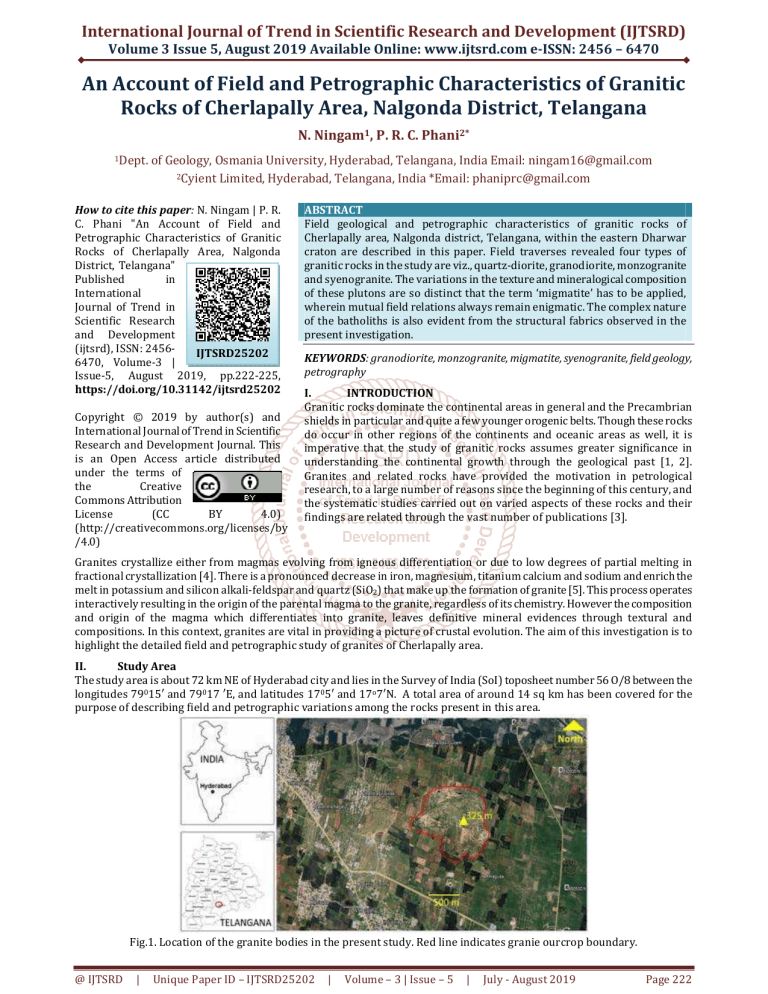
International Journal of Trend in Scientific Research and Development (IJTSRD)
Volume 3 Issue 5, August 2019 Available Online: www.ijtsrd.com e-ISSN: 2456 – 6470
An Account of Field and Petrographic Characteristics of Granitic
Rocks of Cherlapally Area, Nalgonda District, Telangana
N. Ningam1, P. R. C. Phani2*
1Dept.
of Geology, Osmania University, Hyderabad, Telangana, India Email: ningam16@gmail.com
2Cyient Limited, Hyderabad, Telangana, India *Email: phaniprc@gmail.com
How to cite this paper: N. Ningam | P. R.
C. Phani "An Account of Field and
Petrographic Characteristics of Granitic
Rocks of Cherlapally Area, Nalgonda
District, Telangana"
Published
in
International
Journal of Trend in
Scientific Research
and Development
(ijtsrd), ISSN: 2456IJTSRD25202
6470, Volume-3 |
Issue-5, August 2019, pp.222-225,
https://doi.org/10.31142/ijtsrd25202
Copyright © 2019 by author(s) and
International Journal of Trend in Scientific
Research and Development Journal. This
is an Open Access article distributed
under the terms of
the
Creative
Commons Attribution
License
(CC
BY
4.0)
(http://creativecommons.org/licenses/by
/4.0)
ABSTRACT
Field geological and petrographic characteristics of granitic rocks of
Cherlapally area, Nalgonda district, Telangana, within the eastern Dharwar
craton are described in this paper. Field traverses revealed four types of
granitic rocks in the study are viz., quartz-diorite, granodiorite, monzogranite
and syenogranite. The variations in the texture and mineralogical composition
of these plutons are so distinct that the term ‘migmatite’ has to be applied,
wherein mutual field relations always remain enigmatic. The complex nature
of the batholiths is also evident from the structural fabrics observed in the
present investigation.
KEYWORDS: granodiorite, monzogranite, migmatite, syenogranite, field geology,
petrography
I.
INTRODUCTION
Granitic rocks dominate the continental areas in general and the Precambrian
shields in particular and quite a few younger orogenic belts. Though these rocks
do occur in other regions of the continents and oceanic areas as well, it is
imperative that the study of granitic rocks assumes greater significance in
understanding the continental growth through the geological past [1, 2].
Granites and related rocks have provided the motivation in petrological
research, to a large number of reasons since the beginning of this century, and
the systematic studies carried out on varied aspects of these rocks and their
findings are related through the vast number of publications [3].
Granites crystallize either from magmas evolving from igneous differentiation or due to low degrees of partial melting in
fractional crystallization [4]. There is a pronounced decrease in iron, magnesium, titanium calcium and sodium and enrich the
melt in potassium and silicon alkali-feldspar and quartz (SiO2) that make up the formation of granite [5]. This process operates
interactively resulting in the origin of the parental magma to the granite, regardless of its chemistry. However the composition
and origin of the magma which differentiates into granite, leaves definitive mineral evidences through textural and
compositions. In this context, granites are vital in providing a picture of crustal evolution. The aim of this investigation is to
highlight the detailed field and petrographic study of granites of Cherlapally area.
II.
Study Area
The study area is about 72 km NE of Hyderabad city and lies in the Survey of India (SoI) toposheet number 56 O/8 between the
longitudes 79015′ and 79017 ′E, and latitudes 1705′ and 17o7′N. A total area of around 14 sq km has been covered for the
purpose of describing field and petrographic variations among the rocks present in this area.
Fig.1. Location of the granite bodies in the present study. Red line indicates granie ourcrop boundary.
@ IJTSRD
|
Unique Paper ID – IJTSRD25202
|
Volume – 3 | Issue – 5
|
July - August 2019
Page 222
International Journal of Trend in Scientific Research and Development (IJTSRD) @ www.ijtsrd.com eISSN: 2456-6470
III.
Field Characteristics
The Archaean Granitic Complex of Cherlapally, Nalgonda district continues beyond the adjoining districts of Suryapet,
Bhuvanagiri, where these vast stretches of areas consist of several plutons of granodiorite, granite, adamellite and alkali
feldspar granite in the forms of composite batholiths. The study area is made up of massive varieties of granite that are not
metamorphosed in nature and the out crops are seen in the form of tors, boulders which are rolled down along slope of the hills
they are grey in colour devoid of any foliation and lineation. The rock has a well developed coarse grain crystalline in nature
consisting of k-feldspar, plagioclase, quartz with meagre sprinkling of mafic minerals, however there are certain clots where
mafic minerals are seen in higher proportion.
At several places there are mafic enclaves of different shapes and dimensions which are traversed by a late stage felsic injection
consisting of quartz only which run in different directions belonging to different generations.
At several places in north direction part of Cherlapally, a dolerite dyke in the form of discontinuous body is seen cutting across
granites which indicates younger magmatic event. At some places where intrusion contact with the dyke granites is suffered
some amount of deformation that is noticed in the form crude foliation and lineation.
Fig.2. Field photograph of Cherlapally area [A]. Banded appearance of granite with mafic rocks, [B]. View of the typical
weathering of the dolerite dyke [C]. The stretching of mafic enclaves intersected by pegmatite veins, [D].Mafic enclave
within the granite
The field relations at Cherlapally and its adjoining areas are established after careful observations during extensive traverses
carried out in the study area. The geological boundary of the granitoid rocks are demarcated in the geological map (Fig.1).
IV.
Petrographic Characteristics
With the aid of microscopic studies, modal mineral abundances were determined and plotted in QAP ternary diagram (Fig.2A)
[6]. The approximate crystallization trend of various essential and accessory mineral phases has been derived (Fig.2B) [7].
Table1. Modal analyses of Granitic rocks of the Cherlapally area
Sample No. C2
C3
C4
C5
C6
C7
C8
K-Feldspar
48
34
62
48
19
47
54
Quartz
23
22
20
26
28
18
22
Plagioclase
16
38
12
14
46
14
12
Biotite
6
2
1
6
3
6
5
Hornblende
3
2
1
4
2
8
3
Sphene
1
0.5
2
1
1
1
Zircon
0.5
Opaques
2
1
1
2
5
2
Apatite
1
1
1
1
1
Total
100 100 100 100 100 100 100
@ IJTSRD
|
Unique Paper ID – IJTSRD25202
|
Volume – 3 | Issue – 5
|
July - August 2019
Page 223
International Journal of Trend in Scientific Research and Development (IJTSRD) @ www.ijtsrd.com eISSN: 2456-6470
Fig.2.[A]. QAP Modal classification for the granitic rocks (after Streckeinsen 1974,). [B]. Sequence of approximate
crystallisation of minerals in granite at Cherlapally.
The petrographic characteristics of the four granitoid rock types in the study area are described here under (Fig.3.A to D). The
diversity in the mineralogical composition and the complex character of the granitic rocks of the study area are mainly
attributed to either to a single petrogenetic process or by a combination of several polyphase episodes.
Fig.3: [A]. Granite displaying the twinning of feldspar. [B]. the lamellar twinning of Plagioclase feldspar and Microcline. [C].
Displaying the twinning of plagioclase feldspar in association with quartz and untwined plagioclase. [D]. Displaying the Kfeldspar in association with myrmekitic intergrowths of feldspar and quartz.
@ IJTSRD
|
Unique Paper ID – IJTSRD25202
|
Volume – 3 | Issue – 5
|
July - August 2019
Page 224
International Journal of Trend in Scientific Research and Development (IJTSRD) @ www.ijtsrd.com eISSN: 2456-6470
A. Quartz diorite: The quartz diorite is marked by
plagioclase dominant than K-feldspar with less than 20% of
modal quartz. The felsic minerals are very coarse and the
plagioclase is sericitised plagioclase and a reddish brown
coloured mineral which secondary mineral derived from the
alteration of pre-existing mafic minerals.
Acknowledgement: Sincere gratitude to Prof. Mādabhooshi
Srinivas, Head, Department of Geology, Osmania University,
Hyderabad for guidance, encouragement and support. The
authors thank Dr. S. Bhattacharji, Director, Petrology
Division, Geological Survey of India, Southern region,
Hyderabad for thin-section preparation.
B. Granodiorite: The granodiorites are chiefly made up of
plagioclase feldspar, K feldspar, quartz, hornblende and
biotite in different percentages. The accessory phases
include sphene, opaques, apatite and zircon in the
decreasing order of abundance. The mafic content is
hornblende dominant and is in conformity with the
increasing in K- feldspar content. The rock is coarse-grained
and exhibit hypidiomorphic-granular, granoblastic and
porphyroblastic textures. In non-porphyroblastic units,
plagioclases and K-feldspars are subhedral and subequigranular.
References
[1] Dowty, E. (1980) Crystal growth and nucleation theory
and the numerical simulation of igneous crystallization.
In: Hargraves, R. B. (ed). Physics of magmatic processes.
Princeton University Press, New Jersey, USA, pp. 419485.
C. Monzogranite: The monzogranites of the study area are
medium to coarse grained and exhibit hypidiomorphic and
equigranular texture and have colour index around (30) %.
The mafic minerals included the amphibole and biotite, with
former more prominent with sieve textures and relict
pyroxenes. The amphiboles which are noticed in the form of
large prismatic subhedral outline, they exhibit light green to
light brown pleochroism and marked by low extinction
angles and +possess serrated edges. The presence of biotite
is bare minimum and nominal and occasionally the
amphibole itself is seen transforming to biotite.
D. Syeno granite: The syenogranites of Cherlapally are Kfeldspar dominant rocks that constitute around 47- 53% by
volume and have nearly quartz and K-feldspar in more or
less equal proportions and correspond to granitic
composition. Potash feldspar, plagioclase feldspar and
quartz constitute the essential minerals in this entire group.
@ IJTSRD
|
Unique Paper ID – IJTSRD25202
|
[2] Narayanaswami, S. (1966) Tectonic problems of the
Precambrian rocks of Peninsular India. Proc. Symp
Tectonics, Hyderabad, pp. 77-84 (quoted from
Ramakrishnan and Vaidyanathan, 2010).
[3] Ramakrishnan, M. and Vaidyanathan, R. (2010)
Geology of India, v. 1, Geological Society of India Publ.,
556p
[4] Bowen, N. L. and Tuttle, O. F. (1950). The system
NaAlSiO3- KAlSi3O8-H2O. Journal of Geology. V. 58. p.
489.
[5] Tyrell, G. W. (1926). The Principles of Petrology: An
Introduction to the Science of Rocks. Chapman and Hall,
London. pp. 61-64.
[6] Streckeisen, A. L. (1973) Plutonic rocks: Classification
and nomenclature recommended by the IUGS
subcommission on the systematics of igneous rocks.
Geotimes, v. 18, pp. 26-30.
[7] Srinivas.M and Ningam.N (2015) Petrology and
geochemistry of granites from Kowdipally area, Medak
district, Telangana, southern India, IJEE ISSN 09745904, Vol. 8,No 4, August , pp 256-258.
Volume – 3 | Issue – 5
|
July - August 2019
Page 225


